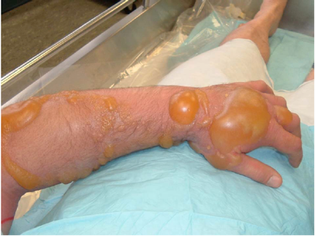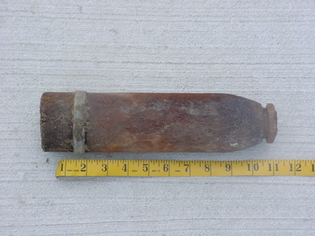http://www.nytimes.com/2014/12/31/us/veterans-chemical-burns-expanded-military-doctors-knowledge-but-his-care-faltered.html DEC. 30, 2014 A Veteran's Chemical Burns Expanded Military Doctors' Knowledge, but His Care Faltered By C. J. CHIVERS LORDS VALLEY, Pa. -- Daniel Mould's sense of abandonment was profound. An Air Force staff sergeant wounded in a chemical weapon accident in 2004, he willingly helped the military study his wounds. From his bed in a Philadelphia burn ward, as blisters from sulfur-mustard agent erupted on his skin, he signed a waiver allowing doctors to gather his body fluids to experiment with new laboratory methods for confirming chemical exposure. Over the next 18 months, as the military gave him attentive care and doctors prepared peer-reviewed journal articles about his case, another branch of the service, the Army, concluded that it needed to be exhaustive in tracking troops exposed to chemical warfare agents: Citing Sergeant Mould's burns, it called for monitoring victims for life. [1] The case seemed a welcome example of the military's working closely with a patient to improve understanding of a rare battlefield risk and to develop practices to learn from patients' medical experiences. Then came the shift. When Sergeant Mould accepted medical retirement in 2006, he was suffering a cascade of health problems, but he said he had been assured of long-term monitoring. Instead, he said, "the Air Force never contacted me again. I've never been tracked." In October, reacting to an investigation by The New York Times, [2] the Army surgeon general's office announced that it would begin monitoring the long-term health of all veterans exposed to nerve or blister agents during the American occupation of Iraq. The victims had been kept secret as long as a decade, and the Army's treatment guidelines had not been followed. For Mr. Mould, 45, who had never spoken publicly about the accident, the irony of the Army's announcement was startling. Even the person whose wounds spurred one branch of the military to call for tracking exposed veterans had not been enrolled in long-term monitoring -- by either the Pentagon or the Department of Veterans Affairs. The origins of his case span almost a century of American chemical-warfare policies, and like the experience of Iraq -- where troops were wounded by abandoned chemical weapons -- his example speaks to the persistent dangers presented by discarded or forgotten munitions. Almost all of the military's previous chemical-exposure victims had been World War I veterans or human subjects in classified military tests during World War II and the Cold War. The latter group, tens of thousands of enlisted men, were systematically exposed to nerve and blister agents in gas-chamber tests, field exercises or other efforts to evaluate protective equipment and human reactions to chemical-warfare agents. Often the human subjects were sworn to silence. The Pentagon denied their existence for decades, until victims came forward with medical claims, prompting a 1993 review of the military's conduct [3] by the National Academies' Institute of Medicine, which noted "a well-ingrained pattern of abuse and neglect" of the human subjects, some of whom had been duped into consent. That review also found enduring negligence: "No formal long-term follow-up medical care or monitoring was provided" for exposure victims, even though follow-up, the authors said, "could have provided a wealth of information on the effects of these war gases." Tracking exposure victims is important, military and health officials say, because blister and nerve agents can carry long-term effects. Sulfur mustard, for example, can cause lingering respiratory difficulties and is carcinogenic, although precise risks have proved hard to measure in the limited studies to date. That legacy of squandered opportunities appeared to change by 2004, when Sergeant Mould was burned. His wounding was like a case study in the long-lasting dangers of modern weapons. In 1917 and 1918, the United States brewed chemical agents for use on Europe's front lines, only to find it had little storage capacity for thousands of tons of chemical artillery shells that had not been fired before the armistice in 1918. The Army found a solution: Dump them off the East Coast. "War Gas Dumped Far Out At Sea," read the headline on a New York Times article in 1919, [4] which noted that one vessel dropped 200,000 shells overboard between 60 and 100 miles out. Little is known of the locations of many shells, which were scattered by multiple ships. But out of sight did not mean out of reach. One shell intersected with Sergeant Mould more than eight decades later, after the police found a rusted artillery projectile at a chicken farm in Delaware in the summer of 2004. The projectile had been brought ashore by a fishing vessel and delivered to the farm with a load of crushed clamshells to be used as roadway fill. Sergeant Mould, at the time assigned to an explosive ordnance disposal team on Dover Air Force Base, was dispatched to pick up the shell and bring it back the base. There, he said, he and a more senior noncommissioned officer misidentified it as a conventional, high-explosive 75-millimeter round. The next day, Sergeant Mould's team was assigned to destroy the shell. The plan was to breach it with a small shaped charge, causing its suspected contents to burn out and minimizing the risk of a larger blast or fragmentation. After the team detonated the shaped charge, Mr. Mould recalled later, something was clearly wrong: The shell was leaking a "liquid about the consistency of vegetable oil and black as the ace of spades." The liquid, he said, smelled like hot asphalt. A more senior disposal tech, he said, proposed that the shell was a tar-filled practice round. The three techs sealed it in garbage bags to contain the odor and planned to finish destroying it another day. As the team packed the round, sticky liquid spilled onto Sergeant Mould's sleeve. At 4 a.m. the next day, Mr. Mould recalled, he woke in pain. Blisters were rising on his left hand and arm. He understood immediately that what he had thought was tar had been a chemical warfare agent. Sergeant Mould drove to an emergency room. Two other techs suffered exposure in the incident, including one who had a small chemical burn above one knee, according to the Air Force incident report. One did not reply to requests for comment; the other could not be reached. Sergeant Mould's wounds required 10 days of hospital care and two months of convalescing at home. From the start, he agreed to cooperate with military doctors who used his blood, urine and blister fluid to develop laboratory tests that allowed them to confirm exposure as long as 41 days out. One participating doctor praised Sergeant Mould's attitude. "He really was very public-spirited about it," said Dr. Jonathan Newmark, then an Army neurologist at the Army's Medical Research Institute of Chemical Defense. As his burns healed, Sergeant Mould began suffering other medical problems, including post-traumatic stress disorder. He also became angry at what he saw as government shortsightedness and silence. "It turned out that people knew those shells were dumped there," he said. "I can't tell you how that upset me." In the years since, 15 more of the same type of mustard shells have come ashore in clam boats and been recovered from the Sea Watch International seafood plant in Delaware, said Dave Foster, an Army spokesman. By then, prompted by Sergeant Mould's case, the procedures had changed. The shells were all destroyed in a specialized, sealed chamber known as an explosive destruction system, [5] Mr. Foster said. Another Air Force technician suffered mild chemical burns several years later retrieving one of the mustard shells from the clam-processing plant. Reached by telephone, that victim declined to comment, beyond saying that she remained on active duty and that the Air Force had handled her case well. Sergeant Mould was medically retired in 2006. His records show that he has suffered depression, reactive hypoglycemia and cardiac problems. He said he had been troubled by the military's lack of curiosity and follow-up. "I can't tell you that my health problems were caused by mustard," he said, "but I can't be sure there is not a connection, either." As his health failed, he said, the Air Force ceased following his case, and the V.A.'s handling of his routine medical care was so inadequate that he stopped visiting the department's hospitals. The Air Force confirmed that it did not have a policy for long-term monitoring of its veterans exposed to chemical agents -- like the one developed by the Army after Sergeant Mould was exposed -- and that it stopped following him when he left active duty. When his care was handed off to Veterans Affairs, doctors there said, Mr. Mould was treated through 2009 for a range of health problems, but he had not been enrolled in long-term surveillance and the department had not tried to reach him since 2011. Dr. Paul Ciminera, director of the V.A.'s Post-9/11 Era Environmental Health Program, said that now that other mustard-exposure victims [6] had become known from Iraq, the V.A. had begun working with the Department of Defense to decide how best to track victims over time. After The Times inquired about Mr. Mould's case, the Army said it would enroll him in a regimen of lifelong health monitoring -- a step Dr. Newmark said made sense. "Going forward, it is pretty clear that what we ought to do for these people is have a long-term safety net in place," he said. Mr. Mould said this was all he had sought years ago. "I'd love it," he said, "if they'd just do what they said." John Ismay contributed reporting.

U.S. Army Medical Research Institute of Chemical Defense Blisters from sulfur-mustard agent erupted on Sergeant Mould's skin as he lay at a Philadelphia burn ward in 2004.

Daniel Mould/United States Air Force The 75-millimeter shell retrieved by Sergeant Mould and his team- mates, taken the day before they attempted to destroy the round. [1] http://www.nytimes.com/interactive/2014/10/14/world/middleeast/us-army-regulations-for-treating-chemical-warfare-casualties.html [2] http://www.nytimes.com/interactive/2014/10/14/world/middleeast/us-casualties-of-iraq-chemical-weapons.html [3] http://www.nap.edu/openbook.php?record_id=2058 [4] http://timesmachine.nytimes.com/timesmachine/1919/03/09/97082131.html [5] http://www.cma.army.mil/fndocumentviewer.aspx?docid=003682454 [6] http://www.nytimes.com/interactive/2014/10/14/world/middleeast/iraq-chemical-weapons-medical-records.html